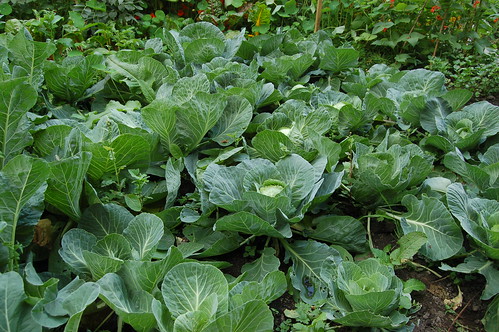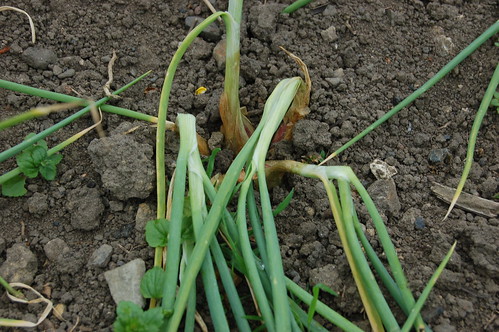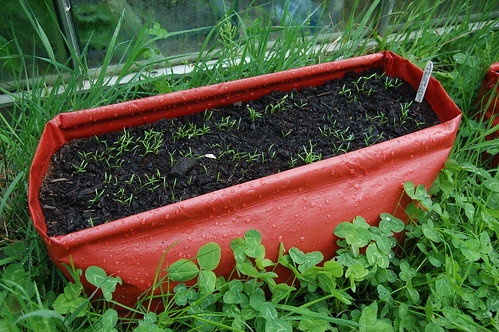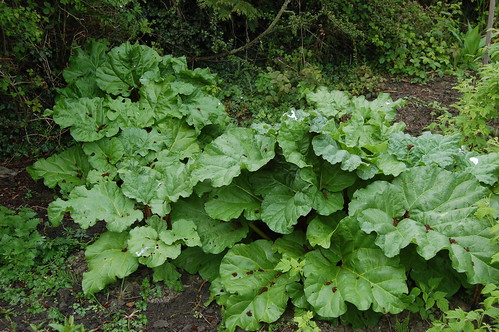We grow our own food in a suburban village in the North East of England. Follow us as we keep up the battle to be self-sufficient.
Wednesday 8 December 2010
Cauliflower leaf soup
The cauliflower crop was very successful on the allotment this year. We therefore had a glut of both cauliflowers and cauliflower leaves. I wasn't entirely happy with throwing the leaves onto the compost heap so I did a search and found nothing of interest in terms of cauliflower leaf recipes. So I set about creating my own.
Cauliflower leaf soup is the result. It contains nettles and nasturtiums as well. I filmed this video in the summer on how to make it.
Wednesday 1 December 2010
Snow damage
The snow has put an end to plans to make more leaf mould, gather hawberries for making ketchup and digging up Jerusalem artichokes.
The snows have arrived
The good news is that when I returned home I found a couple of pheasants had been delivered by Johnnie, a friend who goes shooting. I'll be plucking and gutting soon!
---
Sent via BlackBerry
Wednesday 24 November 2010
Breadcrumbs and using up the sausage meat
To do this, I removed the skins and put the meat into the food mixer along with three leeks, garlic, fresh herbs, bread crumbs, an onion and a couple of eggs. I also added in some left over gravy and cheese source from a previous meal.I then mixed them all together and baked them at 180C for 90 minutes. We ate a slice with some fried up potatoes and runner beans left over from a previous meal. It wasn't the best meal I have made but it wasn't bad.
Most of the meal therefore consisted of ingredients that most people would throw out. Admittedly we had to buy the eggs and the onion (our crop of onions is close to being used up) but the rest were either leftovers or came from the allotment. The loaf will do us for about three meals.
We keep a box of breadcrumbs in the pantry and I advise everyone else to do the same. Breadcrumbs are a useful ingredient and can be made easily from stale ends of loaves that would otherwise be thrown out, fed to the birds or put on the compost heap.
Tuesday 23 November 2010
How to make sweet mince
It's autumn so thoughts turn to mince pies. And also to how I can use up the pears and apples that I picked in the early autumn but which won't survive storage over the winter. Using them to make sweet mince was the solution. So, in this video, I show you how to make sweet mince using apples and pears.
Making leaf mould

November may be the time when most of the crops are harvested but there is one resouce that is abundant at this time of the year and should be harvested in large quantities: tree leaves. They make an excellent compost and soil conditioner. The problem is they take at least a year to rot down.
To make leaf mould, rake up fallen leaves in an area away from main roads and put them into large, bin-liner bags. Store the bags for a year in the corner of the garden or allotment. During the year, the leaves should rot down and their volume considerably reduced. You will then have a good quality compost ready for use. (If you feel the leaves have not rotted sufficiently, leave them in the bags until the following spring).
Thursday 18 November 2010
Newsletter now ready
Self_sufficient Newsletter No 1 November 10 (Email)
Monday 15 November 2010
Rosehip jelly
So, how to make rosehip jelly:
half fill the jam pan with apples (chop the larger ones) and rosehips. The ratio to each other is up to you but I suggest to get sufficient rosehip taste, the weight of rosehips should be at least 40% of that of the apples.
Cover completely with water and apply heat to boil the mix. When you have reached boiling point, turn down the heat to simmer the contents for about 2 hours, so that the apples have pulped. Add a bit more water if needed.
Strain through a jelly bag and measure the liquid. Put the pulp to one side.
Put the liquid into the jam pan and boil it. When it has reached boiling point, add sugar - 1kg for every litre of liquid. Bring the liquid back to the boil and keep boiling (and stirring) until the setting point is reach. (To test, put a spoonful on a plate and leave to stand for a couple of minutes - if a skin forms, it is ready.)
Pour into warm, sterilised jars.
The jelly is a lovely red colour.
You can use the pulp to make fruit butter rather than throw it onto the compost heap. Put it back in the jam pan and add water, sufficient to ensure it is a wet pulp. Reheat the pulp and boil it for about 5 minutes.
Allow to cool and then press it through a sieve. Return the resulting puree to the jam pan (measure it first), then boil it. As soon as it boils, add a kg of sugar for every litre of puree.
Bring it back to the boil and keep boiling until the setting point is reach (check in the same way as above). Then add to warm, sterilised jars.
I may have a go at making more rosehip jelly. I've still got a pile of apples left to use up so it may be that I'll do a video about it as well. Watch this space.
Sunday 14 November 2010
Use leftover lemon skins to make marmalade
If you use lemons in jam making (they are a good source of pectin for jams and jellies for those soft fruit that are low in pectin) don't throw out the lemon skins. Use them instead to make lemon marmalade. We put lemon skins into a bag in the freezer and keep adding to it until the bag is full when we boil them all up to make marmalade. This video shows you how.
Saturday 13 November 2010
How to make a sweet cucumber and gerkin relish
The greenhouse gave us a huge crop of cucumbers this year and the allotment provided a seemingly endless supply of gerkins. So we made them into a sweet relish. The video shows how you how to make it.
How to make blackberry jam
Another late video from me so apologies! Blackberry jam is very easy to make and blackberries are abundant in the late summer and early autumn. So I recommend this one for those starting out in jam making.
Here's the video on how to make it.
How to make cauliflower cheese
We had a glut of cauliflowers on the allotment this year and during August we filmed a few videos about cooking cauliflower recipes. Alas, we've been a bit busy recently and have only managed to edit the videos slowly. This one is about how to make cauliflower cheese, always a great Brotish classic dish.
I've already posted up how to make aloo gobi but coming up are cauliflower and stilton soup, piccalilli and summer green leaf soup (which contains cauliflower leaves).
Friday 5 November 2010
The smells of an autumn kitchen
The berries and apples are in the jam pan at the moment, simmering away as I make another batch of hedgerow jelly. And I am making a vast quantity of sweet mincemeat. I am using a bag load of wild pears I picked recently along with some of the wild apples I picked a couple of months ago. The mix will stand overnight and tomorrow it will spend a bit of time in the oven before the brandy is added.
Bread baking was also done today for the next week. Finally, I am about to have a large jam tart with cream. I made it a couple of days ago with some of last years jam (bramble butter). We need to use up the old stocks to make room (and I am also running out of jam jars).
And finally, another of my bottles of elderflower champagne blew its cork in the garage today. I'm down to 15 now.
---
Sent via BlackBerry
Monday 1 November 2010
How to make hedgerow jelly - the video
Autumn brings a great crop of wild berries and fruit from hedgerows. I've been out recently picking blackberries, sloes, elderberries, hawberries, crab apples and rosehips. One of my favourite autumn preserves is hedgerow jelly (and its by-product hedgerow butter). In this video I show you how to make them.
Sunday 31 October 2010
How to make crab apple jelly - the video
There are still plenty of crab apples around and they are great for making jellies - they are packed full of pectin, that all important ingredient for setting jam (along with acid, heat and sugar!)
We make crab apple jelly most years. It can be spread on jam but is also very pleasant with cold meats.
Saturday 30 October 2010
Filming for the Horticultural Channel
The website is being developed but you can visit it at http://thehorticulturalchannel.tv.
Wednesday 27 October 2010
Bye-bye piccalilli
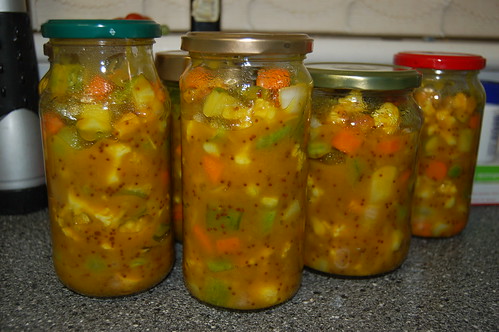
The plan to become self-sufficient can have some unintended outcomes if we don't think properly about what we are doing. If we have a surplus, we get a table at a local makers' market so sell it and to promote what we are doing to encourage others to grow at least some of their own food.
Alas, we took all the piccalilli we made in August to our first makers' market last week and ended up selling it all. This was a mistake. We have made 7 jars and we should have held some back for ourselves. We have had great reports from those who bought a jar but we never had the chance to taste it ourselves. We will have to wait until next year to make some more!
I do have a video filmed about how to make picalilli. It's not edited yet. Things have been a bit busy recently. I'll try and get it sorted soon.
Pink fir apple potatoes

I'm not sure if I need some therapy for this but I have been raving recently about how good the pink fir apple potato is. It is one of the crops of potatoes we grew this year and we are very pleased with the results. It has a lovely pink skin - though how fir apple comes into the name is not something I can answer.
Cook them in their skins which are after all their most nutritious part. Lightly boil them. Very good as a salad potato.
This is one we are hoping to grow again next year.
Going nuts about hazel
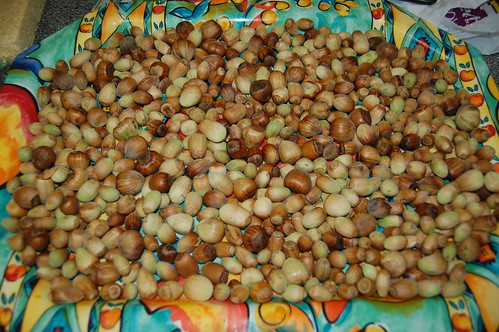
If you haven't yet got in your hazel crop it is probably too late. The squirrels would have beaten you to it. Hazel nuts are one of our wonder foods. They are high in vitamins and essential oils. But what really interests us in the protein. They are stuffed full of it. And as we aim to become self-sufficient, having a good supply of protein in the face of reduced meat consumption is really important.
Over the past month I've been out picking hazel five times in local woodland. Most will be used in nut loaves. We have stored them in a hessian sack in our garage. Nice and cool and dark there.
Friday 15 October 2010
Jam production line
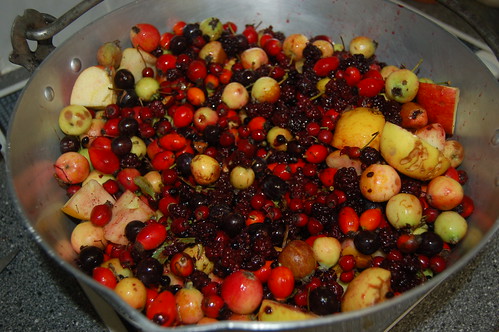
I am having a jam-making day. Yesterday I set away some hedgerow jelly and having strained the pulp overnight, today I carried out the final stage of turning the strained liquid into jelly. I then pressed the pulp through a sieve and made hedgerow butter from the puree.
Not content with that, I made some bramble jelly using some leftover blackberries and crab apples. On the cooker at the moment is a pan full of crab apples which I will use for making crab apple jelly.
Tonight however I am off the jam treadmill. Instead I will be making pear and apple chutney. The apples were picked wild in September but I picked the pears over the weekend from a derelict orchard near our village.
And finally, if you haven't picked your hazel nuts, get them as soon as possible. They won't last much longer. I've been out five times to pick them and have gathered about 6kg. That's our protein supply guaranteed for a few months!
(Photo is of the hedgerow jelly ingredients - minus the sugar of course)
Tuesday 12 October 2010
Another fully self-sufficient dinner
I have subsequently stripped the pheasant and the meat will be chopped up and mixed with mashed potato and coated with breadcrumbs to be fried, later this week. The bones were used to make stock for a leak, potato and nasturtium soup. I picked the leaks on Sunday. They were actually thinnings but I had no desire to see them go to waste.
---
Sent via BlackBerry
Beekeepers' meeting
---
Sent via BlackBerry
Saturday 2 October 2010
The problems of storage
I extracted from the freezer earlier this week a bag of lemon skins to make into marmalade. This barely scratched the surface in terms of freed up space. There is a large bag of blackberries in the freezer as well and my plan is to use it in a hedgerow jelly recipe. But it rained and rained through the week, preventing me from picking the other berries I need. As I have now come down to London for a few days, the jelly will have to wait. So the freezer continues to be full.
What we have no space for are the runner beans and cabbages. Dad is kindly donating space in his freezer for the beans though there are still loads to come in. I'm rather concerned about the cabbages however. They are still on the allotment and the rabbits are getting fat on them.
We are pickling what we can. Runner bean chutney is interesting! But we are going to have a big sort of all the food stores when we get back to free up freezer space. Were we to get to the bottom of our chest freezer, it could be interesting what we find!
---
Sent via BlackBerry
Friday 1 October 2010
Lemon marmalade
I've made quite a bit of blackberry jam recently so we have been getting through quite a few lemons. So here's a tip you may want to try to cut down on waste. Save the lemon skins. Add them to a bag in the freezer and when it's full use them to make lemon marmalade.
Boil up the skins but keep a few fresh skins for shredding. Add the shreds to the strained liquid and reboil, adding 1kg of sugar for every litre of liquid.
Check for the setting point then add to warm, sterilised jars. the result is a good sharp marmalade, produced from something that would otherwise be thrown onto the compost heap.
---
Sent via BlackBerry
Friday 24 September 2010
How to make blackberry vodka - the video
It's autumn so there is an abundance of blackberries. In this video we made blackberry vodka.
How to dry tomatoes
We have a glut of tomatoes from the greenhouse but didn't want to freeze them or preserve them by making them into a pickle or ketchup. So we had a go at drying them. This is how we did it.
Allotment update - August 2010
Sorry this is late. My excuse is that I've been away for quite a bit of September. The video covers our beekeeping course, harvesting potatoes grown in bags and picking cauliflowers, runner beans, tomatoes, baby leaks etc.
Saturday 18 September 2010
Making blackberry jam
Blackberry jam recipe
Put your blackberries into the jam pan after weighing them.
For every kilo of blackberries add the juice of 2 or 3 small to medium lemons.
Apply heat and bring to the boil.
Keep the pan simmering until the fruit has become a mushy pulp.
Stir in the same weight of sugar as weight of blackberries and bring back to the boil.
Keep boiling until the setting point is reached (to test for this put a tablespoon of jam onto a plate, allow to cool and if it forms a skin, it has reached the setting point).
Then add to warm, sterilised jars.
---
Sent via BlackBerry
Friday 17 September 2010
More blackberries
The blackberries are early again this year. In my youth we used to call school half term in October "Blackberry Week" as that was when we went picking blackberries (sometimes we called it potato picking week). I wonder if climate change is changing the times when wild crops are ready for picking.
Tuesday 14 September 2010
The price of food
Changing eating habits, growing what you can, wild food foraging and most importantly, avoiding food waste can have a major impact on a household budget. As food prices continue to rise, we are all going to have to be more intelligent with the way we get our food and use it.
---
Sent via BlackBerry
Sunday 5 September 2010
More crops
The tomatoes were semi-dried in the oven for four hours and then stored in a jar of olive oil. Everything else has gone into the freezer, including the cauliflower leaves (steamed first).
We kept one cauliflower aside however to make cauliflower cheese. Watch out for the video on this. I'll edit and post it up soon.
---
Sent via BlackBerry
Saturday 28 August 2010
Unstuffed leaves
I steamed some cabbage leaves to soften them. Into the paella I added from the allotment onions, a shallot and tomatoes. From the supermarket came a bit of chorizo sausage. The cabbage leaves however turned out to be a bit too small for stuffing. The experiment didn't quite work. So, I simply laid them on the plate to make a bed for the rest of the meal (which included some new potatoes - the first of our crop - and home made nasturtium pesto).
How to make nasturtium pesto
Last year we grew nasturtiums on the allotment as a food crop. They have a habit of spreading and smothering everything in sight. This year we didn't plant any but we still have plenty of them! So we have been harvesting nasturtium leaves for use in salads and soups. However, I had been planning to make nasturtium pesto so in this video I have a go at making it.
It turned out to be rather tasty. Our plan had been to use it on some pasta but we decided instead to put it on some boiled new potatoes from the allotment. Very nice!
Beekeeping
During the course, a swarm of bees appeared so we trooped out to watch Mark and Kym capture it.
We also checked out the bee hives.
We hope to start keeping bees next year. Watch this space!
Friday 27 August 2010
How to make strawberry and gooseberry jam
Plenty of strawberries on the allotment this year so we decided one way to use them up was to make strawberry jam. Strawberries however are very low in pectin so to get the jam to set, you need to add fruit that is high in pectin. That normally means adding lemon. This time however we opted for gooseberries. These are high in pectin and are a great complement to strawberries. See the video to see how I got on.
Thursday 26 August 2010
Watch out for cauliflower recipes
Watch out for the forthcoming video on using the cauliflower glut I have been filming. It's not finished yet but I hope to have it on YouTube soon.
How to bottle fruit
Bottling was a common way to preserve fruit before freezers were widespread and in an attempt to keep the skill alive, I taught myself bottling last year. This year we are doing more bottling. Our freezer is full so we have to bottle fruit if we are to stand any chance of preserving it for use over the coming months.
In this video I bottle gooseberries and cherries.
Saturday 21 August 2010
Thinning and cropping
The leaks should have been thinned some time ago but hopefully they will now have space to grow, as will the parsnips. We kept the thinnings. I used the leak leaves and the stems of the onions that had bolted to make vegetable stock. This was then used to make a cauliflower and green leaf summer soup. That's the rather fancy name I have conjured up for this recipe. The idea behind it is that I wanted to use cauliflower leaves rather than throw them away. I'm rather proud of the final result as it was a great soup yet most ingredients would otherwise have been thrown straight onto the compost heap.
I'll post up the recipe shortly.
On a beekeeping course
Our plan is to get bees soon (though probably next year) but we want to learn the ropes before going ahead. Reducing our intake of commercially produced sugar by producing our own honey is a key step towards becoming self-sufficient.
By an amazing coincidence, a swarm of bees was found on the farm this afternoon so we all got kitted up and rushed out to watch it captured and placed in a box to be taken to Northumberland where the Pritchards live and keep their hives.
Friday 20 August 2010
Jam tarts, apple pies and aloo gobi
We still have some jam left from last year and we want to use it up as soon as possible as we need the storage space for this year's preserves. 24 jam tarts barely scratched the surface but they did taste fantastic! I also made an apple pie from the apples I bottled last year. I've not tried it yet so can't comment on its quality. The apples were a bit of a mush as it was not my most successful attempt at bottling fruit (it was also my first attempt so I was learning the hard way!)
I also had a go at making my first aloo gobi today. We still have a load of cauliflowers growing on the allotment so cauliflower recipes are popular reading with us at the moment. If you are interested, our cooking with cauliflowers will be on a YouTube video soon. We've filmed (today) how to make aloo gobi but we will also be filming how to make cauliflower and stilton soup, green leaf soup (using cauliflower leaves) cauliflower cheese and deep fried cauliflower with a dip. There may also be a cauliflower curry coming up soon as well.
Thursday 19 August 2010
Something has been eating our broad beans
Anyone any recipes for mice? I think I will refer to my ancient Roman cookbooks!
Monday 16 August 2010
Bottling, rhubarb, cherries and gooseberries

If like me your freezer is full and you want to try a more traditional way to preserve produce, try bottling it. I first tried bottling fruit last year, learnt from my mistakes and now find it quite straightforward. In the past month I have bottled gooseberries, cherries and rhubarb (admittedly not a fruit but regarded as such by most people).
My mistake last year was to use kilner jars that were too large. Get some kilner jars that are small enough to be completely emmersed in your deepest pan.
Top and tail gooseberries before bottling but don't stone the cherries. Rhubarb should be cut into lengths of less that 2cm. Pack the fruit as tightly as possible into the jars.
Sugar syrup should contain 200-250g of sugar per 600ml of water. Pour the sugar into warm water in a pan and bring to the boil. Leave to boil for a minute then allow to cool slightly (only slightly) before pouring into the fruit filled jars. Seal the jars. If you are using screw top jars do not fully tighten the lid. This is because you will now add the jars to a pan of warm water. Make sure there is a table cloth or a wooden pan stand in the bottom of the pan as the jars could crack or break if they are in contact with the base of the pan when being boiled. Apply heat to the pan. The water should completely cover the jars. The rubber ring in the kilner jars should allow out the pressure during heating. Not fully closing the lids on screw top jars will also allow out the pressure.
Heat the pan to close to boiling point and allow to simmer for a couple of minutes. At that point, they are done.
If you want to use honey instead of sugar, recipes I have seen suggest that is quite workable. As an historian, I guess that using honey has a much longer history for bottling fruit than sugar. So far I haven't used honey as we don't have our hives yet. However, we are going on a beekeeping course soon!
We are planning to use the bottled fruit in pies and desserts later this year.
Break in at the allotment
Then on the allotment this evening our neighbour called round to tell us he had had a break in over the weekend and equipment had been stolen. Alas the route the thieves had used was through our allotment. The hedgerows with the derelict allotment next to ours was cut back by the owner recently with the result that gaps have opened up. So tomorrow we are going to fence off the whole length of if, all 12 metres.
---
Sent via BlackBerry
A good crop of cauliflowers and cabbages
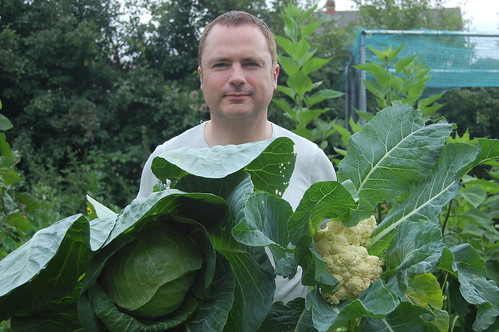
This photo was taken a week ago. The cabbage and cauliflower crops are coming along very well. We are having to pick some of the caulis now before the florettes open out and grow separately. So far we have had cauliflower cheese and caulifloer and stilton soup. I want to have a go at aloo gobi, one of my favourite Indian dishes. I've never made it before but I have eaten it many times. I'm also planning some spices fried cauliflower dipped in a sauce. I'm still hunting recipes for this.
We didn't grow cauliflowers last year and the year before that when we did manage to grow was more an excuse for a crop than the real thing. So we are very pleased with this year's produce.
How to make raspberry and rhubarb jam
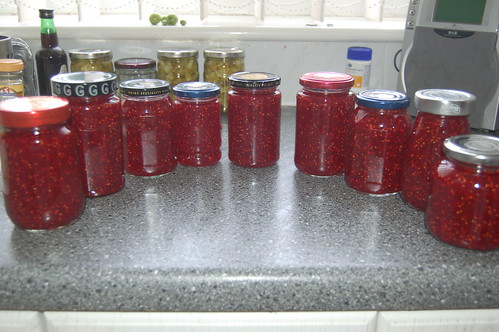
I made this jam last night. It is very easy to make and tastes lovely. The raspberries were picked wild though we are very much at the end of the season (though we have some late summer raspberries growing on the allotment). The rhubarb we grew on the allotment.
What to do:
The ration of raspberries to rhubarb varies according to taste but I used slightly more by weight of raspberries to rhubarb simply because of the quantities I picked (900g of raspberries to 800g of rhubarb).
Chop the rhubarb into lengths of less than 1cm. Add raspberries and rhubarb to the jam pan. Add the juice of two medium lemons for every kg of raspberries and rhubarb. Apply heat. When it boils, leave it simmering until everything has pulped. Then add sugar - same weight of sugar as total of raspberries and rhubarb.
Bring back to the boil and keep boiling until it reaches the setting point. The add to warmed jars.
Saturday 14 August 2010
Watch out for those wild fruit and nut crops
I am on the train from Crystal Palace to Victoria in London at the moment and can see a great crop of blackberries and elderberries along the railway embankments. It is still a couple of weeks to go before we can start picking elderberries back in the North East but the blackberries are beginning to ripen there as well. So be ready with jam and wine making recipes - and pies as well! Try bottling the fruit as well for later use. One of my videos still waiting to be edited is about bottling cherries. Use the same techniques with blackberries. The video should be posted up soon (I may even try to edit on the train to Newcastle this afternoon).
Rowan, or mountain ash, are ripening as well. They are very common though rowan jelly, which is easy to make, is a bit of an acquired taste though it goes well with cold meats.
Apples are also beginning to ripen as well. Check along country lanes in particular. The bad habit of some drivers of irresponsibly tossing their litter from their cars does sometimes result in seeds in discarded apple cores growing into trees. The apples are free for the picking so go get them. Watch out for crab apples as well. They will be ready soon. These are best used in making jellies as they have a good level of pectin. I've never used them for anything else but have set myself the task of finding other uses for them.
Raspberries are still in abundance and you can't beat raspberry jam. Pick them by the bucketload.
Check out old orchards and road verges for pear trees. You will be surprised how many you find. Further south they will be ripening soon. Up north give them a few weeks.
Rosehips are now ready for picking. They can be used in jam making. We are going to dig out wartime recipes for rosehip syrup. Rosehips are very high is vitamin C.
The gooseberry season is probably at an end now but keep your eyes peeled in hedgerows. There may be an odd bush that hasn't given up its bounty yet.
Sloes are just starting to ripen in London. They still need a couple of weeks but get the sloe gin recipes ready. They can also be used in jams and jellies. It will be a bit longer before they ripen up North.
And so on to nuts! Food foragers and those trying to become self-sufficient love hazel nuts. They are the wonder food of the community. They are packed full of protein and oils. Lotties Wood, next to our village of Sunniside in Gateshead, has hazel in abundance. They aren't ready yet but further south they are starting to ripen. Do not hang around before picking them. You will be in an intensive competition with grey squirrels for hazel.
Beechnuts will be ready soon though they tend to elude me. Whenever I pick them they are little more than dried out skins inside the husks. However I am not prepared to give up on them yet.
Acorns will need about another 4 weeks. We use them for making flour. Admittedly you have to be heavily into food foraging and self-sufficiency to do this. I am keen however to look at other ways to use acorns. When I was in the Atlas Mountains in Morocco last year, I heardof people there collecting acorns and cooking them. But I did not witness it first hand and since then my attempts to find anything on the internet has drawn a blank. If anyone can help me on this, I would be eternally grateful.
And finally sweet chestnuts. They aren't ready yet. They probably need at least another month. When they are ready you will need heavy gardening gloves to pick them. As well as roasting them they can be used to make flour for cakes. We've not tried it before as we didn't have enough but we did use them with hazel to make nut roasts. If we get a big enough supply, we will definitely be making flour. We have an eye on a woodland near David's sister's house. I found loads of sweet chestnut trees there at Christmas last year. Too late for picking at the time but this year we are planning an expedition there.
So happy foraging!
---
Sent via BlackBerry
Friday 13 August 2010
How to make cherry vodka
We've been making fruit licquers recently. In this video we make cherry vodka but you can also see our sloe gin and raspberry gin at the end. Before you ask, we used Sainsbury's Basics Vodka. Don't use any expensive brands.
Thursday 12 August 2010
How to pickle gherkins
Gherkins in abundance from the allotment and in this video we pickle some in a sweet pickling vinegar.
Monday 9 August 2010
Coming up
---
Sent via BlackBerry
Disappointing garlic crop
If you are expecting a good garlic crop, one thing we found over the last year was that good storage is important. We hung all our garlic in our garage (nice and cool, little direct light and we don't keep the car in it.) But by the start of this year, we found it was drying out. So, I suggest splitting a good crop. Half to be hung up; the other half stored in olive or cooking oil.
---
Sent via BlackBerry
How to pickle gherkins

The summer glut of gherkins is in full flood so I have put together this recipe for a sweet pickling vinegar to pickle gherkins. I went for sweetness as 2 years ago when we last had a successful gherkin crop we pickled them in ordinary pickling vinegar and found the end result disappointingly sharp.
So here's the recipe for sweet pickling vinegar and how to pickle gherkins.
The first job to do is sprinkle salt on the gherkins and leave them to stand for 24 hours. Then rinse them.
Pack pickling jars or large jam jars with whole gherkins. Slice longways those too large to fit in or where whole gherkins won't fit the space left.
To make one litre of sweet pickling vinegar you will need:
One litre of white wine vinegar
400g sugar
1 tablespoon of mustard seeds
2 teaspoons of celery salt
2 teaspoons of turmeric
one teaspoon ground mace
2 cinammon sticks
1 teaspoon black peppercorns
1 tablespoon of coriander seeds
Put the vinegar into a pan and begin to heat it. Add and stir in the sugar and then add all the spices and seeds. Bring to the boil and simmer for about 10 minutes. (Actually, I say this makes one litre but in reality a bit of the liquid is lost to evaporation.)
Let the vinegar cool but when it is still hot pour onto the gherkins, filling each jar to the brim. Seal and leave for about 6 weeks before starting to use.
Pickles gherkins can keep for quite some time. The ones we pickled 2 years ago are still being used by us, even though we were disappointed at how sharp was the taste. The ones we have pickeld this year however are likely to be used up more quickly.
Below: me with 2 of the 8 jars made in the first batch of pickled gherkins.

We'll soon be doing some pickling recipes with chopped gherkins and cucumbers. Watch this space.
Explosive elderflower champagne
And then overnight 4 of the 30 bottles I made in June decided to fire off their corks in the garage where they are brewing. Most of the bottles have corks rising from the nozzle and are only held in place by the wire cages put on them when they wwere first bottled. I fear however that we will lose more of them before the year is out.
Meanwhile, watch out for forthcoming posts on making red champagne. I first came across red champagne when I was in the Crimea five years ago. I haven't made it before but I guess I can ferment blackberry and elderberry juice in champagne bottles. The later blackberries will be better as they tend to be more juicy but setting it away in October should mean we can be drinking it in time for Christmas.
Christmas potatoes are growing
The potato bags were a good investment. We grow plenty of potatoes on the allotment so the bags are an addition for us. However, for people with no allotment and only a small garden - or indeed no garden at all - potato bags are very useful. They can be used on patios, balconies and flat rooves.
Our greenhouse is too small

I took this photo a couple of weeks ago and since then, the plants inside have grown further. Inside the greenhouse we have 7 varieties of tomatoe as well as aubergines, peppers, chilies, basil and cucumbers. At the moment the cucumbers are cropping prolifically. We are testing recipes this week for relishes and pickles for cucumbers and gherkins so watch this space for forthcoming posts and videos.
The big problem we have is that the greenhouse is simply too small (it's a 6 X 8). We are thinking of using the plots behind the greenhouse for a polly tunnel. We will make a decision on that shortly.
Meanwhile, we are about to be met by a tidalwave of tomatoes. This year for the first time we are also growing beef tomatoes. They are all green at the moment but are already a good size.
Thursday 5 August 2010
Some of our recent pickings

These strawberries will be used in jam making. The plan is to make gooseberry and strawberry jam. Strawberries have very little pectin but gooseberries have more and using them together means we have a jam that sets rather than runs.

Cherries and gooseberries. I've been picking plenty of cherries recently. The red/yellow cherries are very sweet so tomorrow I'll be bottling them. The black cherries have been made into jam. More about that soon. The gooseberries came from our neighbour Vic's garden. There were too many for him to use so we swapped him some jam for the chance to pick his fantastic crop of gooseberries. A pie will also be on his way to Vic shortly (and yes we will be making a video on how to make a gooseberry pie!)

We have gherkins by the bucket load. These ones have now been pickled in sweet spiced vinegar. In the photo you can see they are sprinkled with salt - the start of the pickling process. As will have a video about pickling gherkins coming up shortly. It's already filmed but we haven't edited it yet.
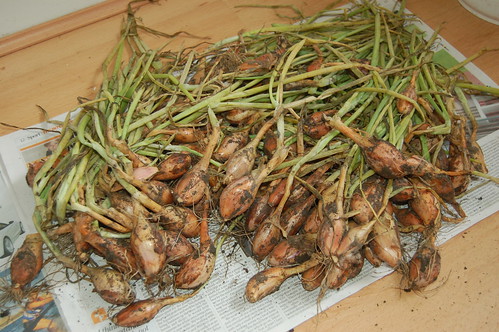
A pile of shallots. This is the first time we have grown them and we had a good crop.
Cherry Vodka

Above: the recently bottled vodka. Below, the pickled cherries which will be used as toppings or in pies and trifles.

Sunday 1 August 2010
An update on bed 1
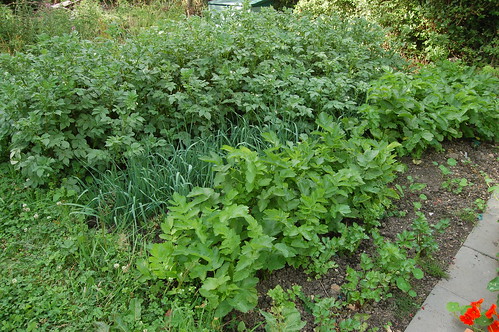
This is bed 1, taken last week. This is the oldest bed on the allotment - so this is the 3rd year we have had crops from it. Top left to bottom right: potatoes, leeks, parsnipsa and celeriac.
The leeks will need thinning, a job I've lined myself up for over the coming few days. The thinnings will be eaten as baby leeks.
Notice the nasturtiums in the bottom right of the picture? We keep having to strip them away from the path. Almost as quickly as we chop them back, they have grown to fill the space. We tolerate them on bed 2 where they grow between the broad beans and don't cause too many problems. If they get onto bed 1, they will smother everything.
Cabbage patch
Sweetcorn

The sweetcorn we planted on bed 3 is coming along very well. We have 26 plants growing and we have now found corn cobbs beginning to develop. We grew sweetcorn last year but the results were at best modest. Hopefully this year we are heading for something more substantial.
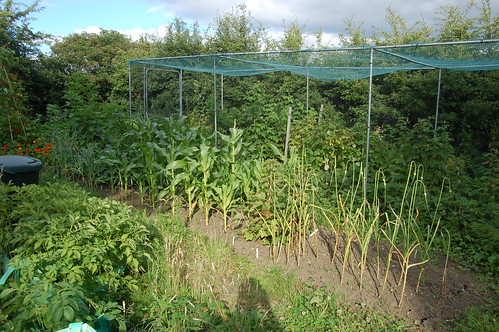
This is bed 3 where the sweetcorn is growing (towards the left of the picture). It shares the bed with garlic, Jerusalem artichokes, courgettes, a blackcurrant bush and shallots, though the latter have now been harvested.
Summer fruit jam
900g strawberries
400g raspberries
400g red currants
All the fruit was added to the jam pan and heat was applied. When it has all pulped down, add in 1.7kg of sugar (ie the same weight of sugar as fruit) and then bring back to the boil. Keep boiling for a few minutes until it has reached the setting point (to test it has, put a spoonful on a plate and leave it to stand for a couple of minutes. If it develops a skin, it has reached setting point.)
This jam is a lovely mix and has a fantastic red colour.

At this point the fruit is beginning to pulp down.
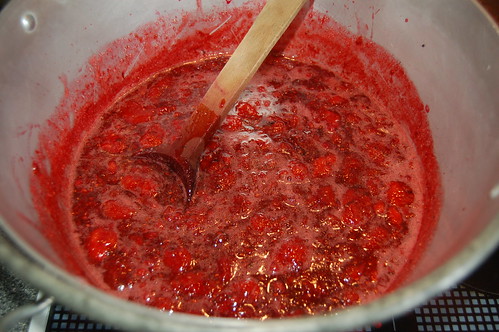
(At this point the fruit has turned to a lovely red coloured mixture.)
Enjoying a sloe gin
One wild crop that has been very successful this year is cherries. Councils love to plant cherry trees because they look pretty in the spring when covered by blossom. My interest is the fruit that starts to ripen in June. Last year, the crop was largely gone by the start of July. I had been in Iceland in the last week of June 2009 filming geysers and waterfalls. My plan had been to pick cherries on my return. And on my return, I found all the cherries had gone. This year they just keep on coming. Bucket loads of them. I was out again this afternoon picking cherries. I have already made cherry jam. More jam will be made tomorrow and I'm planning some cherry fruit leathers. Watch this space (the cherry jam video will be filmed tomorrow).
Today I also picked a bucketful of gooseberries. Our neighbour Vic told us there were too many for his own use so invited us to pick the fruit in his back garden. One of the jams I will make is strawberry and gooseberry. The advantage with this mix is that gooseberries have pectin, strawberries don't. The combination will set. And we have plenty of strawberries on the allotment. Watch out as well for some of the gooseberry pies we will be making soon.
---
Sent via BlackBerry
Wednesday 28 July 2010
Late July update from the allotment
I am concerned about the garlic. Last year we had a fantastic crop. I lifted a couple of bulbs from the ground on Sunday and they were unimpressively small. We'll leave them a few days yet but I am expecting a disappointing crop. Perhaps the weather - our coldest winter in 30 years and a dry spring - have affected them.
Gherkins and cucumbers however are doing well. We have now picked a large number of gherkins and we'll be pickling them shortly.
Fruit growing on the allotment
Latest video from the allotment and we decided to focus on our fruit crops. We have plenty of raspberries, strawberries, blackcurrants and red currants. Watch out for the jams, pies and fruit drinks we have made.
Friday 23 July 2010
Christmas potatoes
The varieties we have are Bambino, Vivaldi, Maris Peer and Carlingford.
---
Sent via BlackBerry
Thursday 22 July 2010
Raspberry picking
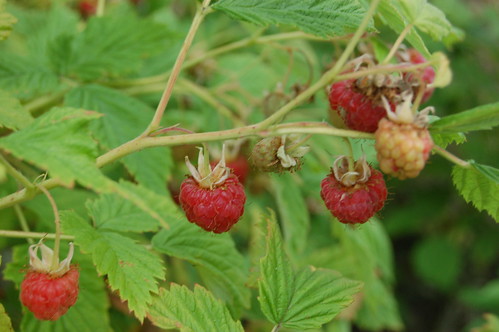
This evening we spent a bit of time picking more raspberries on the allotment. I've got enough to make about 2kg of jam. I need to check on the wild raspberries near our village though last week when I looked, they still had some way to go before they ripened. When they are ready, raspberry jam output will rocket!
Wednesday 21 July 2010
Shallots
Tuesday 20 July 2010
As requested - courgette, gherkin and cucumber photos
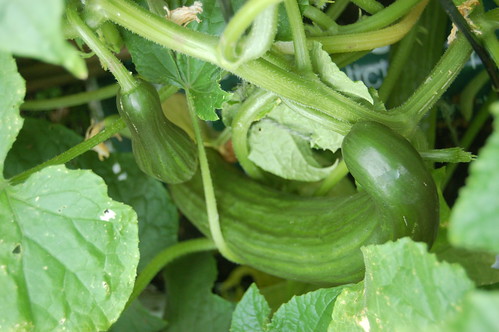
Cucumbers in the greenhouse. We have loads of them. A very successful crop and we will be looking at recipes to use them up shortly. I may even stretch to doing a video.
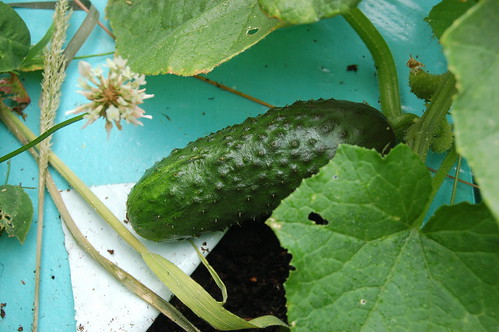
Last year's gherkin crop was a complete failure. This time we are about to be hit by a glut of them. Definitely one for pickling. And there will be a video on this soon - we'll probably film it next week though we are still searching for a recipe for sweeter pickling vinegar.
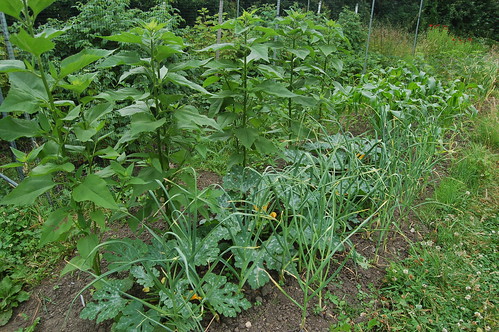
Having posted up all my recent photos onto Flickr (click on the above photos and you will be taken to my Flickr account) I have just realised that I haven't any close ups of my courgettes! The above photo is of bed 3. You can see the courgettes growing in front of the artichokes. We've already had a few meals with courgettes and we are on the outlook for interesting and challenging recipes to try. If anyone has any ideas, please send them to me.
Busy as a bee
Since the visit we have signed up for a weekend course in August that is being held at Bill Quay Community Farm in Gateshead. I'll keep you in touch about how we get on.

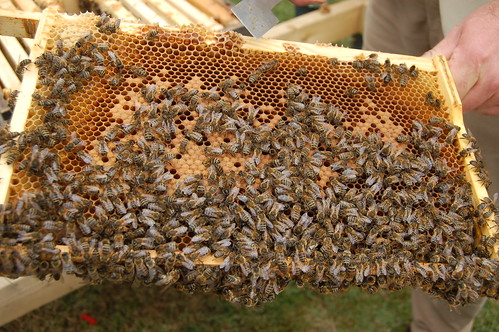
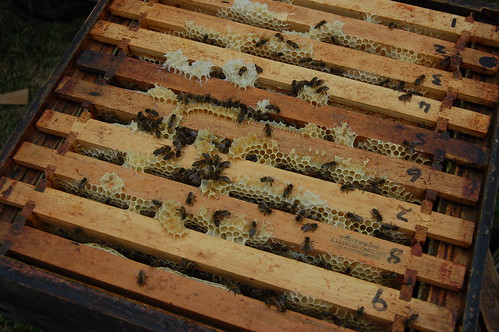
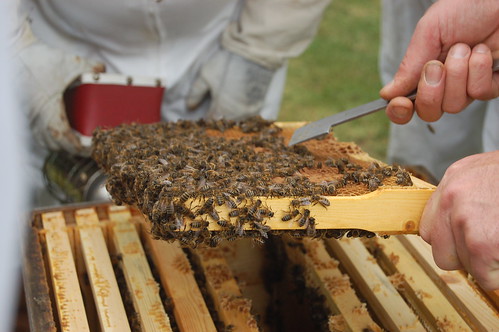
Strawberry puree - watch out for ice cream
I'll probably video my efforts.
Last winter I also planned to make ice cream using recipes used in Georgian country homes 250 years ago. That would have meant getting some ice from the local lake. I was going to video it as well as part of a series I am hoping to produce on historical cooking. Alas, I never got round to making Georgian ice cream but later this year I'll give it a go, assuming we have some ice.
Sunday 18 July 2010
A glut of cucumbers, gherkins and courgettes
This is a big imporvement on last year when our gherkin crop failed. Two years ago we grew them and they were a success. We pickled them and then discovered that the vinegar tasted too sharp. Now we are looking for recipes for sweetened pickling vinegar though as yet have found nothing. We may end up creating our own recipe.
As for the cucumbers we have been using them with sandwiches and lunches but we are probably going to have to pickle some and give some away. The courgettes are in danger of appearing as a side dish with every meal we have!
We are now at the point where we have decided not to do a weekly shop. We now only go shopping for those basics that we are not providing ourselves - sugar, lemons, flour and milk spring to mind. The freezer is full and we are desperate for space so only the absolute minimum of bought food is coming through out front door. We have loads in the freezer to keep us going for weeks, including peasants and ducks plus some of the beans we grew last year. And we still have salted vegetables and bottled fruit from last year to use up as well.
How to make blackcurrant jam
The blackcurrant bushes we planted on the allotment last year have given us our first crop which I picked last week. I turned it all into blackcurrant jam. The video above is how I did it.
One thing to remember about blackcurrants (and red and white varieties) is that they are high in pectin so there is no need to add lemon to get the jam to set. We use the same weight of sugar to fruit. Other recipes I have seen use more sugar. It depends ultimately on how tart you want it. Some recipes add water as well. We didn't this time but were I making jelly instead, I would.
Friday 16 July 2010
More raspberry jam
Wednesday 14 July 2010
How to make nettle soup
The best time for nettles for soup making is in the spring when the plants are your and less bitter and woody. Nevertheless, you can still pick young leaves in July for making into nettle soup. In this video, which admittedly was filmed over a number of different days (you can spot that with the different shirts and stubble growth on my chin!) I make nettle soup but add into it some potatoes left over from last year's crop.
The stock was made from pheasant bones. We traded jam for pheasants earlier this year with a friend who goes shooting. The vegetables used in the stock had all see better days so using them in the stock was a good way of using up food that would otherwise have been thrown onto the compost heap.
Saturday 10 July 2010
Lemon marmalade
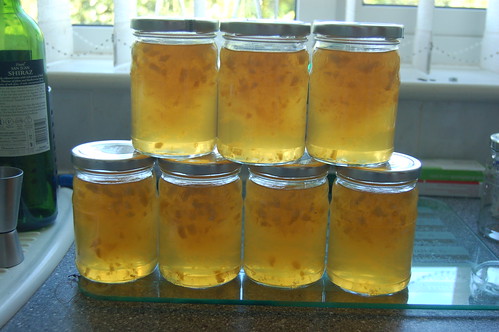
If like me you get through more lemons than you can shake a stick at, don't throw out the lemon skins! I use lemons extensively in jam making - I squeeze them and use the juice as a source of pectin to set jams containing fruit such as strawberries which have very little pectin. Without pectin, your jam won't set. But I end up with piles of lemon skins as a result. And I hate to see waste.
Put the skins instead into a bag and put them in the freezer. Keep adding to them until you have a reasonable quantity. At that point, add them to a pan, cover completely with water and heat until boiling. Leave to simmer for at least an hour.
Shred two whole, seedless lemons (if not seedless, squeeze them then shred the skins.) Then strain your boiled lemon skins and put the skins on your compost heap. (If any one can tell me a further use of boiled lemon skins please tell me!)
Measure the liquid from the boiled lemon skins. Put the liquid into a pan along with the shredded lemons. Bring to the boil. Add a kilo of sugar for every litre of liquid. This makes quite a sharp marmalade so add a bit more sugar if sharpness is not what you are after. Keep boiling until you hit the setting point then add to hot jars.
I've just made 8 jars from lemons used to make rhubarb and ginger jam. It won't last long! We love this stuff and the rest of the family is well supplied with lemon marmalade as well. But it's been a good use of something that would otherwise be thrown onto the compost heap.
---
Sent via BlackBerry
Weeding and the risk of rabbits

(David weeding the cabbage patch on bed 2)
Just back from a weeding session on the allotment. I decided it was time to weed out some of the nasturtiums that have been growing on beds one and two. They are uninvited guests, growing from seeds dropped from the plants we grew last year. I don't mind some growing as they make a nice salad crop but they have the tendency to smother everything in sight. On bed two they were smothering our chard crop. Indeed the chard had come off quite badly. Hopefully, with the nasturtiums removed from that part of the bed, the chard will grow again.
I left the nasturtiums that were growing amongst the broad and runner beans. I suspect the beans will come off better.
Meanwhile, the cabbage patch is coming along very well. We have protected it from hungry bunnies with netting left over from the fruit cage. However, the cabbages were outgrowing the netting and we also needed to get in to weed the patch. So we have taken the risk of removing the netting. The patch is now weeded (see David working on it in the photo above). Fingers crossed that the local rabbit population does not descend on us for a summer time feast.
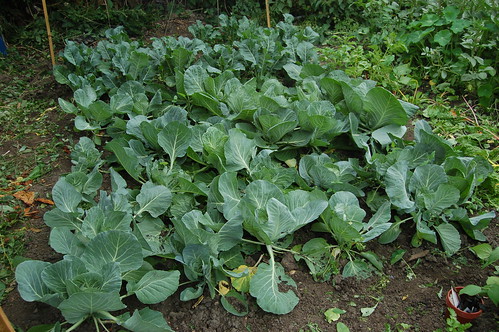
This is the cabbage patch on bed 2. We have some cauliflowers (at the top of the picture) though at the moment there is a great deal of leaf but not much flower.
---
Sent via BlackBerry
Friday 9 July 2010
Potato and nasturtium soup
---
Sent via BlackBerry
How to make hazel nut burgers
Monday 5 July 2010
How to make rhubarb crumble
I have an abundance of rhubarb on the allotment. We've made pies and chutney. We've frozen some of it though the freezer is now full. But we've also made rhubarb crumble so here's the video.
Wednesday 30 June 2010
My rain dance has worked
A couple of days ago I nearly did a rain dance on the allotment. It turned out I didn't need to. On Monday evening we had a heavy downpour. It gave the ground a good soaking. Our water butts also filled up. So, fingers crossed, and perhaps with a bit more rain, the crops will continue growing.
Sunday 27 June 2010
Cherry pie
I also had some blackberries pickled in whiskey which have been waiting to be used up since last autumn. We had long since drunk the whiskey but now I found a use for the blackberries. They made it into the pie with the cherries. The result was rather pleasant.
Thursday 17 June 2010
Rhubarb crumble and pies
Yesterday I made a rhubarb crumble. I have a video on this coming up soon. The day before I made 2 pies. And last week, I made rhubarb and ginger jam.
I'm off to London on business for a week but when I'm back, I'll be making rhubarb chutney, more pies and anything else I can think of.
---
Sent via BlackBerry
Tuesday 8 June 2010
Sweetcorn planted and greenhouse reorganised
Friday 4 June 2010
How to make pheasant burgers
Pheasant burger recipe
Turn your bread into breadcrumbs
Mince or shred the roast pheasant meat
Chop one large onion
Mix the above together and add in a couple of tablespoons of cooking oil.
Beat at least one egg and add to the mix. The egg is needed to bind everything together. If necessary add more egg until the burgers hold together when shaped.
Fry or grill to cook.
Then enjoy.
Wednesday 2 June 2010
Allotment update - May 2010
This is the latest update from the allotment. Crops are beginning to grow.
Greenhouse update
This is the latest update from the greenhouse, filmed over the weekend. Many of the seedlings have been planted out into the allotment already but we have some crops that will remain in the greenhouse: tomatoes, aubergines, peppers and cucumbers.
Sweetcorn will be planted soon in bed 3.
Tuesday 1 June 2010
Growing carrots in bags
Raised bed
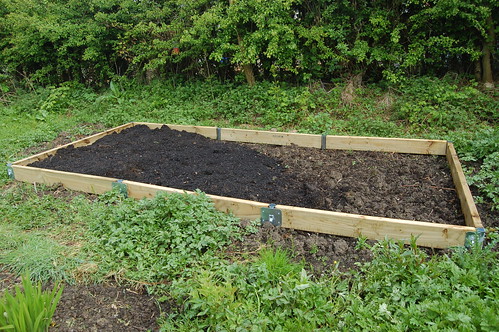
This is the raised bed we have installed on bed 4. As you can see we still need to fill it with earth on the right hand two thirds of it. That will come from the pond we are planning to dig to the left of the raised bed. One third of the bed has been filled with compost from grow bags and potato bags we used last year. We've planted beetroot, radishes and some herbs.
Saturday 29 May 2010
Runner bean wigwams
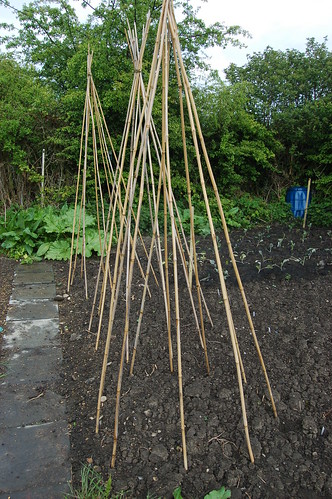
The photo above was taken about 3 weeks ago. We have 3 runner bean wigwams on bed 2, though not on the same part of the bed as they were last year.
We have 3 varieties planted: Galaxy, Scarlet Emporer and an unknown variety from David's uncle and aunt that grew very well last year (better than any other runner bean!).
Since the photo was taken, the beans have been growing and some are now around 5-6cm tall.
Thursday 27 May 2010
Cabbages and cauliflowers under netting
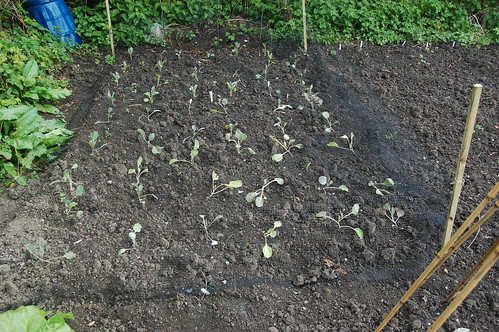
The rabbits has a fantastic meal out on our winter cabbages in January. And what they didn't get, the slugs and snails did. With the entire crop having succumbed to these little critters, we planted summer cabbage and cauliflowers in bed 2. We grew them from seed in the greenhouse and David planted them out three weeks ago. This time, cabbage-munching bunnies can't get at them. We had some netting left over from the fruit cage and this now covers the cabbage patch.
There has, however, been one awful consequence. I found a dead bullfinch under the netting. It must have got trapped there.
The above photo was taken about 2 weeks ago. The seedlings look a bit sickly. However, I'm pleased to say that they are coming on well.
Wednesday 26 May 2010
Lots of rhubarb
Friday 21 May 2010
Getting excited about sweetcorn
Last year we grew sweetcorn for the first time. We got a modest crop though we left some of it too long before picking it. The mice had a fantastic meal of the best cobs!
When they have grown sufficiently in the greenhouse, they will be planted out on bed 3, next to the fruit cage.
---
Sent via BlackBerry
How to pluck and gut a pheasant
Spreading strawberries

I took this photo a couple of days ago of the strawberries in the fruit cage. They are spreading rapidy and much of the ground in the fruitcage is now covered by strawberry plants. Indeed, some have spread under the netting to grow outside the fruitcage. We are happy to let them spread for the time being but we will need to start managing them soon
One of my plans this year is to use the flat roof of our garage as a growing space for plants such as strawberries, nasturtiums and courgettes which spread over the ground. The roof garden plan may need to be brought forward.
Thursday 20 May 2010
Clearing the derelict part of the allotment
Over the past three years we had brought two thirds of the allotment into cultivation. The remaining third has, over the past few weeks now been cleared. We cheated and got someone in to do it for us. The result is a much bigger plot than we expected (showing how overgrown it had become) so it is about 40% of the allotment. In addition we have large piles of rubbish and rubble that need to be removed. Our incinerator was used on Saturday to get rid of some of the wood and brambles but frankly it barely scratched the surface.
I walked around the cleared site this morning and thought about possible uses. I'm still wanting to get chickens so it could be a good locaiton for a chicken run. There will be plenty of space left over for crops.
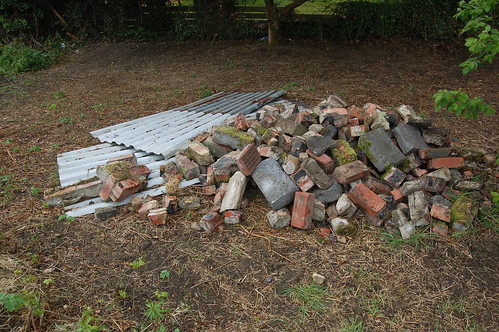
The bricks were from the demolished greenhouse. We are not sure what the corrugated iron was from but we will probably keep it to set up another rainwater collecting system. We collect rainwater in butts from the greenhouse roof but this is not enough for our needs. We have no mains supply on the allotment either.

This photo gives some idea of the size of the newly cleared space.

And this one shows some of the rubbish we need to dispose of.
Sunday 16 May 2010
More weeding and clearing
Bed 4 is about to have some radical work. The raised bed has been constructed and I poured into it bags of old compost that were used for growing potatoes last year. We also need to add more and therefore have something of a compost shortage at the moment.
Bed 4 is also going to be the location for the pond we are planning to dig. There are frogs in the area but we want more of them to eat the bugs. Here's to hoping that in the spring next year, the pond will be a neat little breeding centre for them. Getting the pond dug and established now will give them a good lead in time.
Meanwhile, Kev has done an incredible job at removing the undergrowth on the disused part of the allotment. It looks even bigger than I ever anticipated. Lots of space but lots of work to bring it into cultivation.
Saturday 8 May 2010
Beans, seeds and weeds
The fruitcage has been repaired and the surprise was how strong and heavy the snow must have been to bend the metal tubes that make up the cage. It took a lot of effort to straighten them.
Broad and runner beans have been planted. Three wigwams for the runners for three different varieties - Galaxy, Scarlet Emporer and an unknown variety from David's uncle and aunt that grew very well last year.
Seeds planted earlier in the year are growing well - the courgettes in particular which have come on from seeds to small plants very quickly. Planted this weekend were Swiss Chard seeds outside together with cabbage and cauliflower plants that had been grown from seed. Also sweetcorn has been planted in pots in the greenhouse.
Kev (the person clearing the abandoned part of the allotment) is doing a great job and soon we will have a bonfire and then start digging it over.
Sunday 25 April 2010
Beds and Planters
Bed 1 has been dug over and planted with potatoes. We have gone for Kestrel, Majestic and Pink Fir Apple as the varieties this year - just for a change not any particular reason. We also have planted leeks, parsnips and half a row of chrysanthemums. The latter were a free packet of seeds which filled a patch in the bed.
We have also put two varieties of potatoes into planters (potato bags). In these have gone Charlotte and Mayan Gold. We always have a problem with carrots so this year we are trying carrots in a shallow planter to see what happens.
The seeds in the greenhouse seem to be doing well and this weekend we also planted courgettes.
Sunday 18 April 2010
Spring salads on their way
---
Sent via BlackBerry
Sunday 28 March 2010
Rosemary & Rhubarb
New growth is also appearing on the rhubarb plants as they begin to show above the soil. Again this is something we wondered had been lost due to the cold winter. Maybe Spring really has arrived.
Saturday 27 March 2010
Spring at last - perhaps!
The greenhouse has been cleaned and tidied. Seed potatoes are sitting in seed trays chitting. We have gone for different varieties this year and also have some in very small quantities for growing in bags.
We have planted various seeds - tomatoes, cucumbers and peppers for the greenhouse along with some herbs. Others such as cabbages are for planting out later.
Onions (red and white) along with spring garlic. Five tubers of Jerusalem artichokes have been planted today. This is an experiment as we haven't grown or eaten them before.
Projects we want to start soon are a raised bed to help increase drainage in an area of the allotment which can be quite damp. Also we want to create a pond to give a home to the frogs we keep finding.
